Last night couldn’t believe my luck watching a group of Cornish Choughs at Wheal Coates just before sunset. Truly magical!
It reminded me of the joy and excitement that comes with bird watching in Cornwall, and inspired me to share everything I know with fellow nature lovers, artists, and photographers.
As I’m sat here writing this, I’m excited to share my insights and experiences with you in exploring the beauty of Cornwall’s bird life.
From the rugged cliffs of the north coast to the serene estuaries of the south, Cornwall is home to a diverse range of bird species, making it an ideal destination for bird watching enthusiasts.
In this article, I’ll cover everything you need to know about bird watching in Cornwall, including:
- Eight Amazing Cornish bird species
- Viewing tracks and sites
- Conservation status
- The best dates to witness these birds
Whether you’re a seasoned bird watcher or just starting out, I hope that my knowledge and passion for the birds of Cornwall will inspire you to grab your binoculars and head out into nature to witness the magic of these feathered friends first hand.
Top Bird-Watching Spots in Cornwall
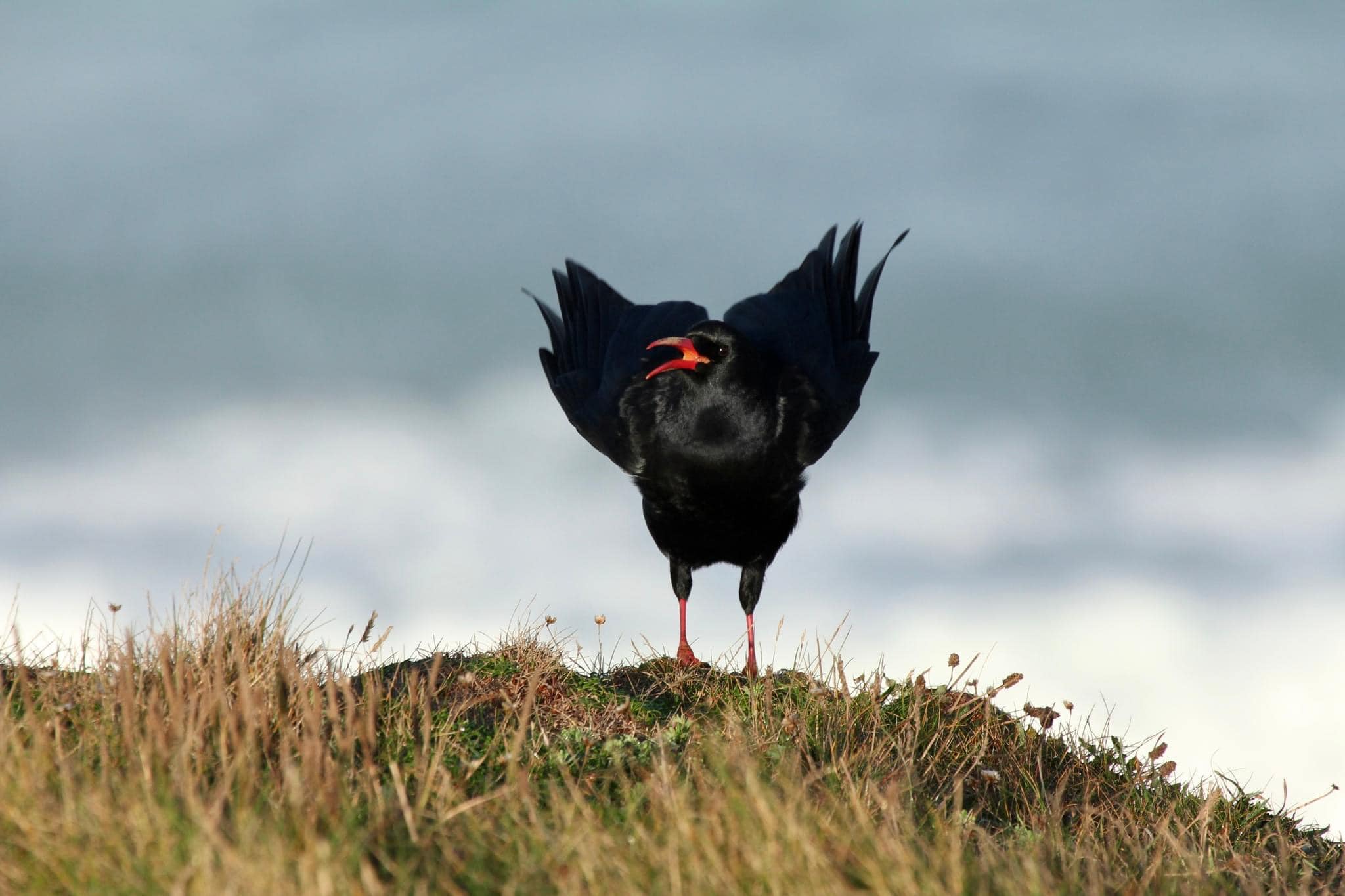
Some of the favourite bird-watching spots in Cornwall include:
- Lizard Point
- The Mounts Bay Marine Conservation Zone
- Penwith
- Various reserves owned by The Royal Society for the Protection of Birds (RSPB)
- Tracks along the South West Coast Path (SWCP), and
- The Isles of Scilly.
Birds to See
Through photographs, bird sighting reports, and “The British and Irish Ringing Scheme” (which involves tagging birds to gather statistics on their population and general activity), we can see how different bird species have been changing in diet, numbers, and location over the years.
Cornish Chough

- Location(s): Cape Cornwall, Lizard peninsula, Mount’s Bay, Watergate Bay
- Estimated population: About 200 (in 2022)
- Conservation status: Green
- Best time of year to view: Year-round
Chosen to represent the Cornish county’s coat of arms, the Cornish chough is discernible from your average group of crows by their bright, cherry-red bill and legs.
Though their conservation status is listed as Green, this wasn’t always the case; the chough once vanished from Cornwall in 1973.
The extinction was likely due to multiple factors such as excessive farmland conversions, reduced grazing of pastures, and trophy hunting.
In 2001, choughs which likely originated from Ireland returned to Cornwall. Twenty years later, it’s thought that 23 nests have produced a total of 66 chicks, and by 2022, the bird population is now estimated to be about 200.
Miraculously, it appears that the bird population is growing steadily once again.
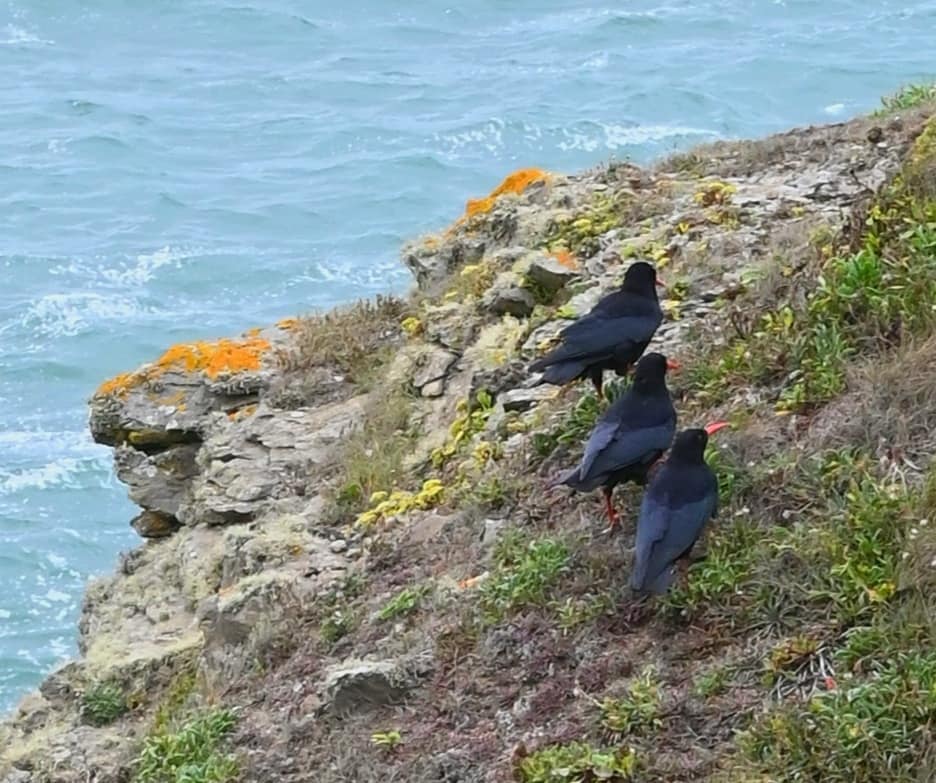
In southern Cornwall, locals have even reported rare appearances of choughs around Lizard point.
Still, places such as Cape Cornwall, Cudden Point in Mount’s Bay, and Watergate Bay beach offer the best locations to hear their “chee-ow” or “kee-aw” calls and catch a glimpse.
To continue the work in preserving these birds, the Cornwall Bird Watching & Preservation Society (CBWPS) now works with farmers to maintain farmland and accommodate the Cornish choughs.
Kestrels and Buzzards
Kestrels and buzzards are two birds of prey in Cornwall. Birds of prey are predators that consume other animals to survive.
Kestrels
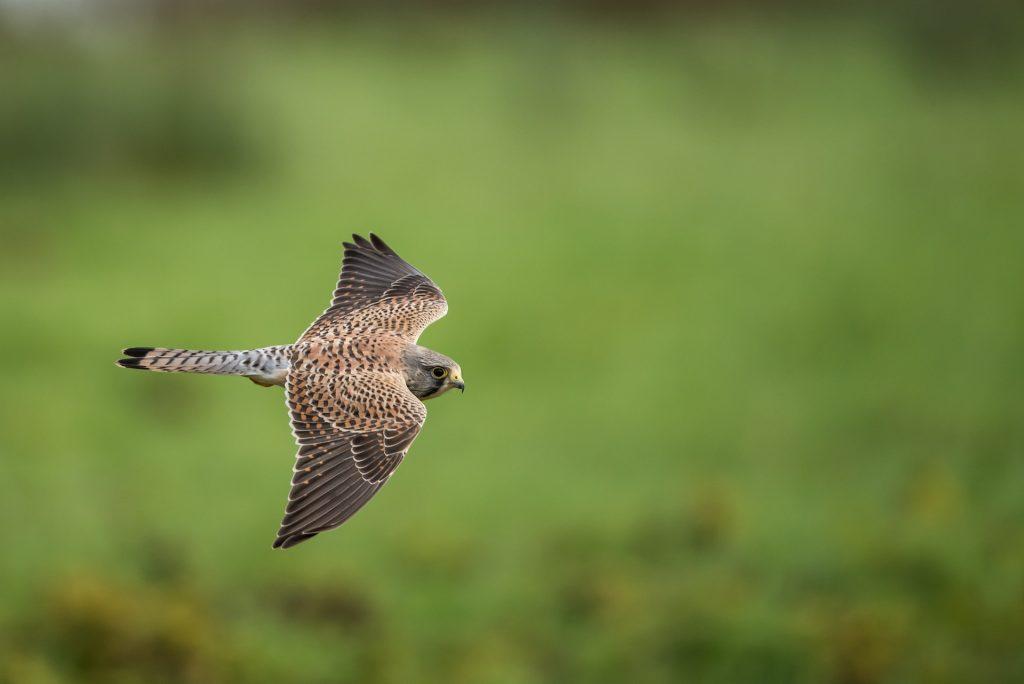
- Location(s): Bodmin Moor, Boscastle and Valency walk, Godrevy, Kelsey Head, Pentire Point, St Ives, SWCP
- Conservation status: Amber (still declining)
- Best time of year to view: Year-round
Noted in the Amber list of the Birds of Conservation Concern, the common kestrel is simply known as the kestrel due to its being the sole kestrel species in the UK.
Kestrels have lighter bases and are stippled with black across their body. They also have a band of black on their tails.
While male kestrels have a chocolate brown tint on their wings and back, female kestrels don an overall soft and subtle brown colour.
Popular for “windhovering” while hunting, kestrels fly into and match the speed of the oncoming wind. This technique allows kestrels to keep their heads entirely still, increasing their hunting efficiency.
If you’re an avid trekker, kestrels have been sighted above the heads of travellers on the gorgeous SWCP, the 1,014-km National Trail along Cornwall’s coast.
At Pentire Point, in particular, the vibrant headland can be found adorned with many perching kestrels.
Kestrels have also been spotted near Willapark in the Boscastle and Valency Valley walk.
Though visible year-round, July is an especially lively month for kestrel sightings around the peaks of the west Pentire Point and Kelsey Head.
Two more places to watch kestrels “hovering” are the Garrow Tor hill in northwest Bodmin Moor and Godrevy.
Buzzards

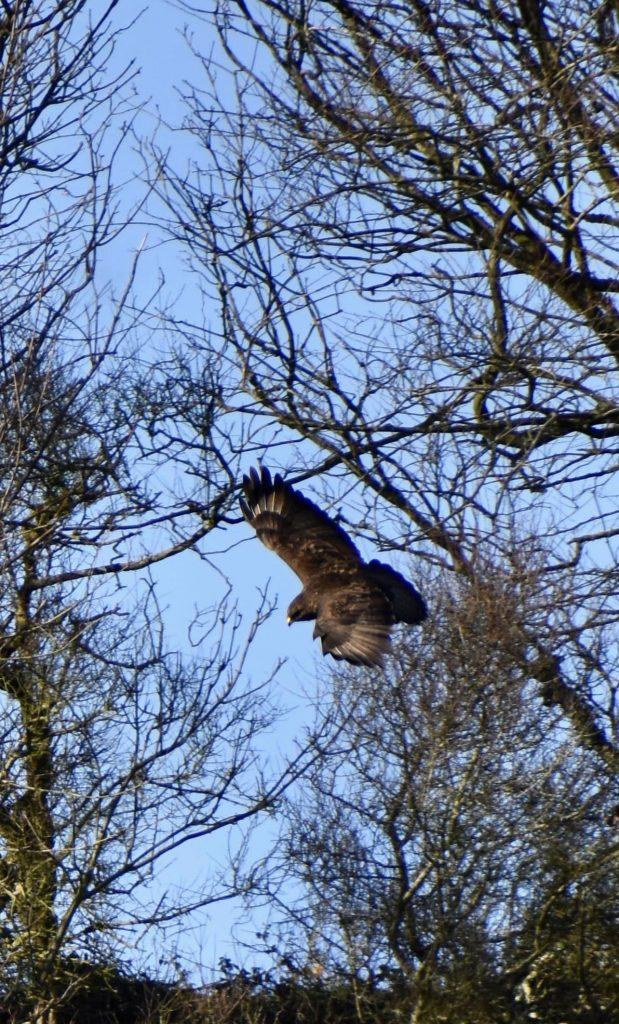
- Location(s): Bodmin Moor, Hayle Estuary, Mount’s Bay, Penwith Point, Porthcurno, St Ives, The Lost Gardens of Heligan
- Conservation status: Green
- Best time of year to view: Year-round
Known for their “pee-uu” or “kee-ya” shriek, the common buzzard and rough-legged buzzard populate the UK!
Unlike the honey buzzard which has longer wings and tails and is commonly found in woodlands, the common buzzard is generally found around grasslands, farmlands, woodlands, heathlands, and moorlands.
Another difference between the common buzzard and honey buzzards is their colouring.
While common buzzards have a brown upper body, yellow legs and beaks, and a pale underside, honey buzzards have more brownish-grey upper body hues.
Prior to the First World War, the buzzard population experienced hardships because landowners were more concerned with preserving game numbers. The use of organochlorine pesticides was also a factor in species decline.
In 2001, it was estimated that there were about 44,000 and 61,000 pairs of the Common Buzzards across Britain.

Generally, you’ll find the common buzzard on sunny days around woody areas hunting for small rodents, reptiles, amphibians, larger insects, and earthworms.
One of the reserves owned by CBWPS, the Windmill Farm, is a great place to see the regular buzzard during summer.
Seasonally, significant locations for seeing buzzards include West Penwith in spring and Porthcurno valley in winter.
Other locations include St Michael’s Mount in Mount’s Bay, Bodmin Moor, and The Lost Gardens of Heligan.
Oystercatchers
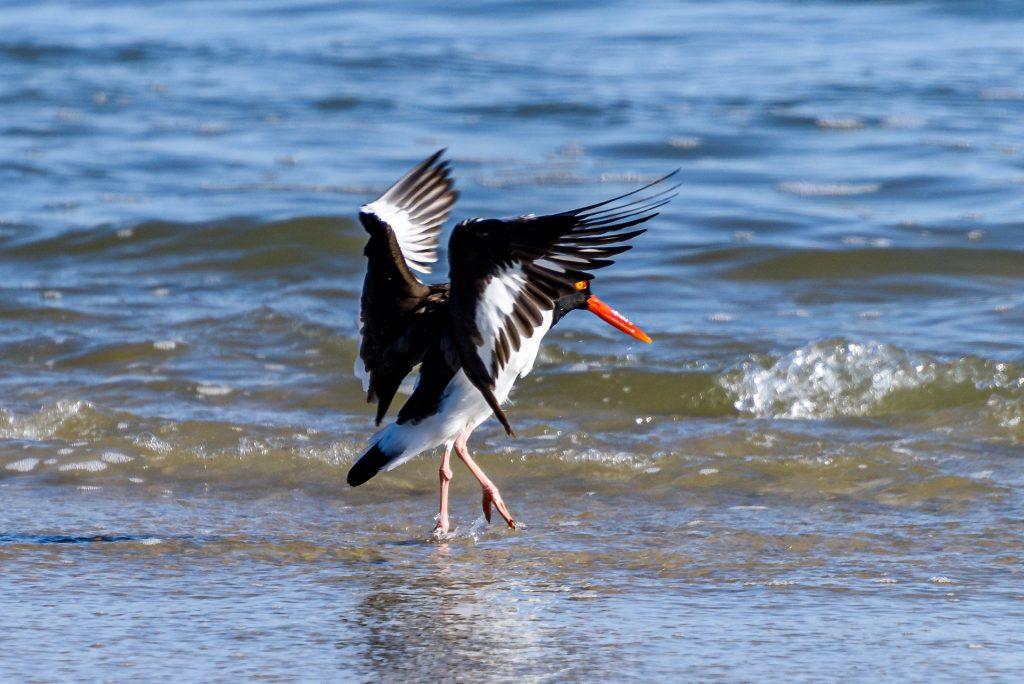
- Location(s): Dodman Point, Hayle Estuary, Looe, Marazion Marsh, Mount’s Bay, Mount Edgcumbe park, Pentire Point, St Austell, St Ives Head, St Mawes, The Isles of Scilly, Trevose Head
- Conservation status: Amber
- Best time of year to view: Year-round
Recognisable by their “peep-ing” cry, the oystercatcher is a wading bird that resides by the coast, freshwater, farmland, wetland, heathland, and moorland.
Visually, you can identify an oystercatcher by its long, blood-orange beak, black-and-white plumage, and rouge legs.
The Old Quay House in the Hayle Estuary, because it’s open at all times and doesn’t have an entry fee, is a brilliant viewing location for oystercatchers, particularly during the winter. Another great winter locale is Marazion Marsh.
Summer is also an excellent time to find oystercatchers at Hayle Estuary and West Pentire Point.
If you’re looking for the perfect romantic honeymoon location close to Cornwall, the Isles of Scilly (St Mary’s, Tresco, and St Martin’s) is an archipelago where oystercatchers have been photographed.
In particular, St Mary’s Porthloo beach saw several oystercatchers with their young in April last year – so this is the perfect time to go!

Every April, Scilly hosts an annual photography competition where you can submit photos of the local wildlife—including oystercatchers!
For the contest’s iteration in 2022, prizes included two day-trip return helicopter rides to Tresco, free entry to the Tresco Abbey Garden, and a lunch for two at The Ruin Beach Café or The New Inn.
Other great locations to spot oystercatchers include the Par Beach Pool in St Austell, St Ives Head, Looe, Trevose Head, St Michael’s Mount in Mount’s Bay, St Mawes, Mount Edgcumbe Park, and Dodman Point.
Starling Murmurations

- Location(s): Bodmin Moor, Davidstow, Helston, Mount’s Bay, Par Sands beach, Pentire Point, Penzance
- Conservation status: Red
- Best time of year to view: October to December
Although they band together to create natural beauty, starlings are sadly a rare sight as they are now a critically endangered species.
Winter is the best season for witnessing mesmerising starling murmurations. During this time, these birds form divine shapes and patterns in the sky—that is, if you aren’t afraid to rug up and head out about an hour or so before sunset.
If you head out on a vigorous 11-km walk from Penzance Station to Marazion Marsh, you may be rewarded with seeing starlings that roost from autumn to early winter.
The Pentire headlands and St Michael’s Mount in Mount’s Bay have also been reported to play host to starling murmurations.
Starling murmurations can be seen in areas such as Penzance, Roughtor and Lower Moor plantation on Bodmin Moor, The Loe in Helston, Par Sands Beach, and Davidstow.
Razorbills

- Location(s): Boscastle, Dodman Point, Gerrans Bay West, Godrevy Head walk, Lizard Point, Pendeen Watch, Port Gaverne, Rame Head, St Ives Island
- Conservation status: Amber
- Best time of year to view: March to July
Razorbills generally occupy coastal cliffs and hunt in the ocean.
Despite their reputation for hiding their nests, these birds nevertheless linger close by and their colony often returns to the same spot to lay eggs.
The razorbill population is estimated to be at around 187,000, though this number is difficult to ascertain because of how challenging it is to access well-hidden razorbill nests.
A relative of the puffin, the razorbill has similar black-and-white body colours. While puffins have distinctly bright bills, the razorbill has truncated, dark beaks with two near-vertical white streaks.
A fun kayak location to chance in the summer is Boscastle, where puffins and razorbills can be seen bustling about the cliff bases and ocean.

Between early spring and mid-summer, you can also kayak and paddleboard the north Cornish coast of the quaint hamlet of Port Gaverne and find the magnificent rock faces that shelter razorbills.
If you’re touring around Gwithian Towans beach, the short Godrevy Head walk (only 0.9km!) is a spectacular spot for razorbills.
Accessible by public bus or car, the walk’s coastal grasslands and cliffs are occupied by these beautiful birds.
Other must-see locales also include Dodman Point, St Ives Island, and Rame Head.
Kingfishers
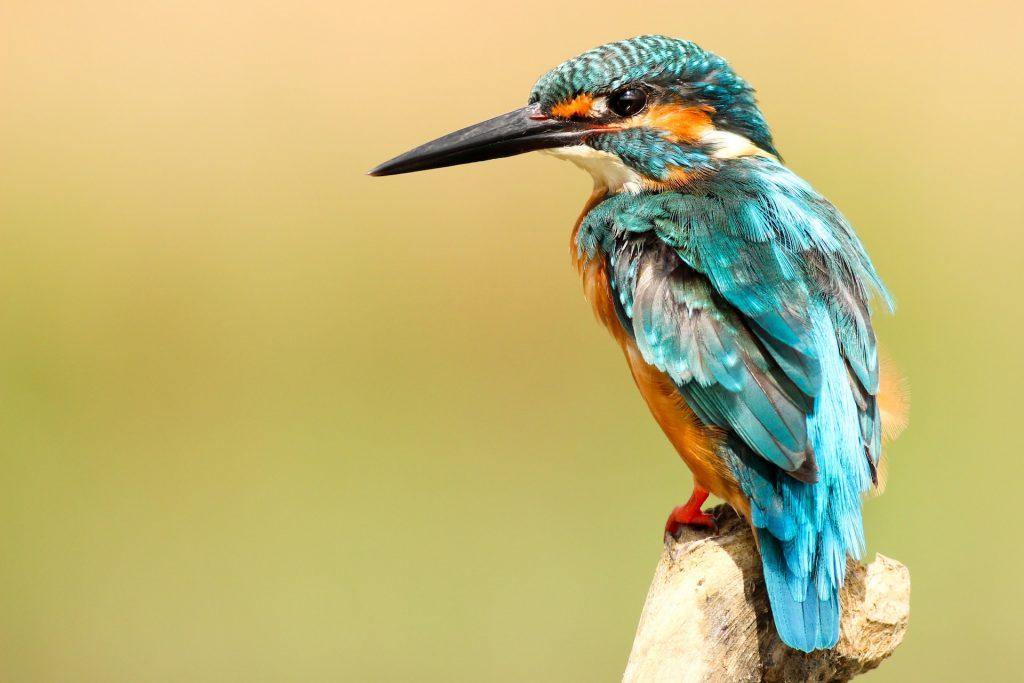
- Location(s): Castle beach, Drift Reservoir, Hayle Estuary, Hayle Harbour, Hayle millpond, Lanhydrock Respryn Ramble walk, Marazion Marsh, Penzance Harbour, Stithians Reservoir, St Austell, St Clement, The Lost Gardens of Heligan, The Isles of Scilly
- Conservation status: Green
- Best time of year to view: Year-round
Discernible by their vibrant copper breast and blue coat, kingfishers are a fishermen’s best friend! These birds reside in nest burrows that they create on the banks of shallow streams or rivers.
Like the oystercatchers, kingfishers can also be seen around Hayle estuary in winter.
Three special local whereabouts for kingfishers include the Lanhydrock Respryn Ramble walk, Hayle Harbour, and Hayle millpond.
On the half-hour Lanhydrock riverside walk, past the Respryn Bridge but before the wooden Kathleen Bridge, you’ll be able to spot kingfishers in the River Fowey.
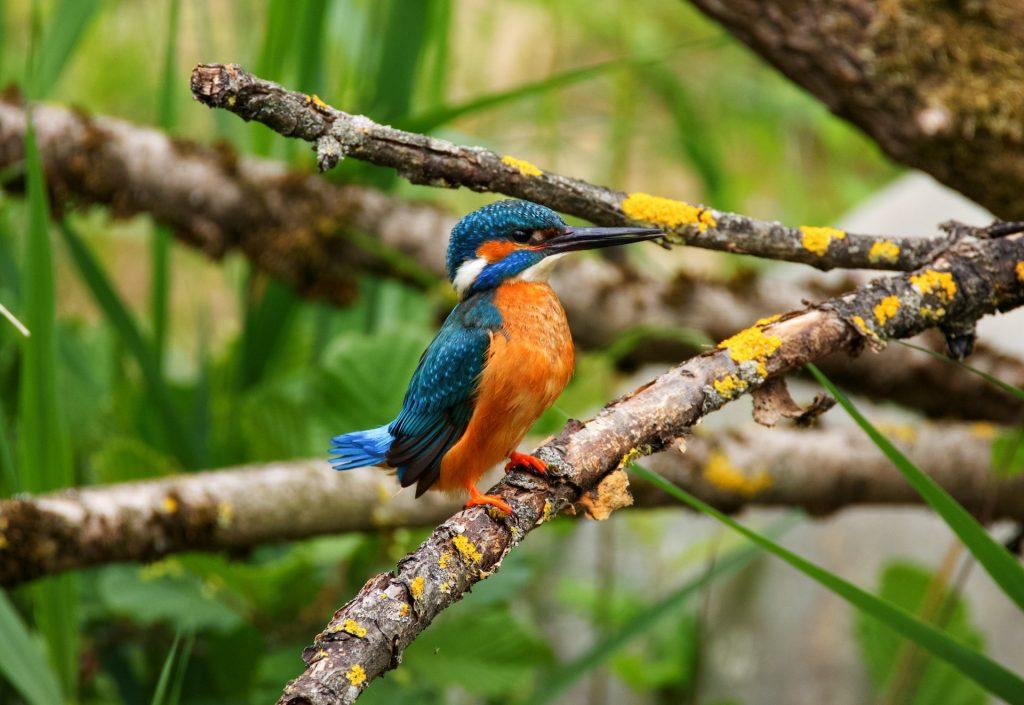
During the summer, Stithians Reservoir and Drift Reservoir also report multiple kingfisher sightings.
If you’re out in autumn, kingfishers have been observed between Penzance harbour and The Isles of Scilly.
From autumn to winter, the abundant ponds of the Lost Gardens of Heligan host a resident kingfisher that visits each morning between 9:30 AM and 11:30 AM – then again in the afternoon from 3:00 PM to 5:00 PM.
Winter sightings of kingfishers include Par Beach Pool in St Austell, Castle beach in Falmouth, and Marazion Marsh.
Herons
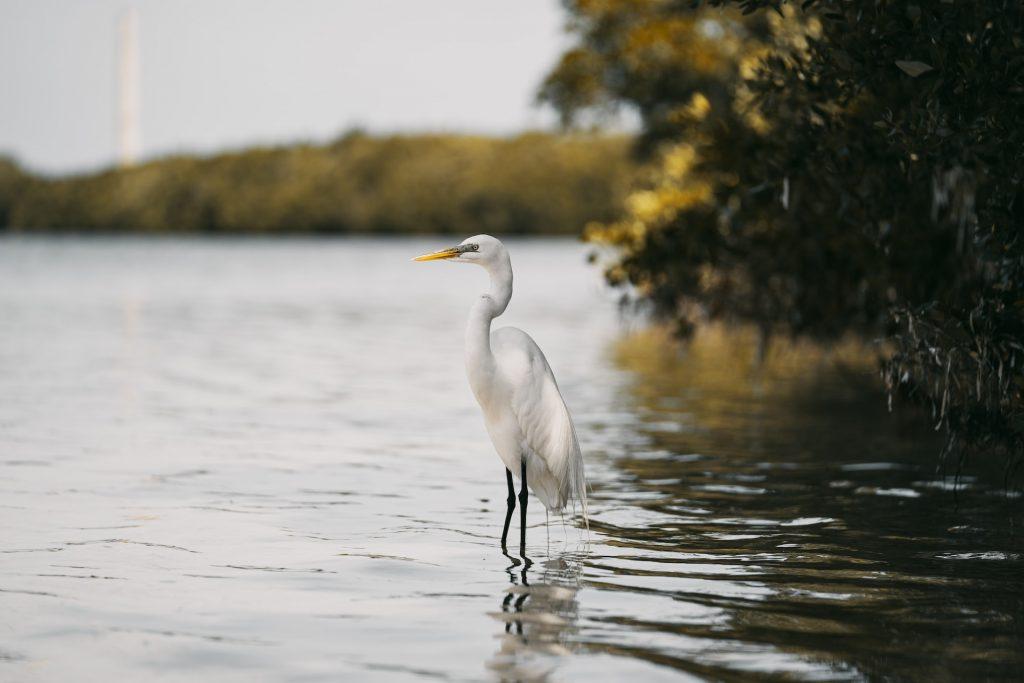
- Location(s): Cornwall Estuary, Crowdy Reservoir, Drift Reservoir, Fal Estuary, Gerrans Bay East, Gerrans Bay West, Hayle Estuary, Marazion Marsh, Penzance, River Looe, Stithians Reservoir
- Conservation status: Green
- Best time of year to view: Year-round
In the UK, three breeding heron species can be found: the grey heron, the Eurasian bittern, and the little egret.
The little egret was once hunted for its plume, but over the years, its population has slowly increased. By 2015, the species had changed conservation status from Amber to Green!
On the other hand, the grey heron is an elegant bird with slender legs characterised by a snow-coloured neck, golden bill, and black eyestripe.
Meanwhile, with its light, chestnut plume covering its curved bowed wings, you definitely won’t get the Eurasian bittern confused for the little egret or grey heron.
And if that’s not enough, you can always identify the bittern by its call; reaching up to 100 decibels, the bittern can project its voice as loud as a jackhammer or a motorcycle!
In terms of habitats, herons generally stick close to bodies of water. The grey heron occupies freshwater such as lakes, streams, estuaries, and coastal areas.
Similarly, little egrets prefer gentle rivers, lakes, flooded fields, estuaries, and shorelines. Bitterns, on the other hand, stay close to wetlands with generous reedbeds and generally emerge at dusk, night, and dawn.
Stithians Reservoir and Marazion Marsh, an RSPB reserve, have been regarded as great places for viewing bitterns, grey herons, and little egrets in Cornwall. River Looe also offers visitors a chance to snap little egrets looking for fish.
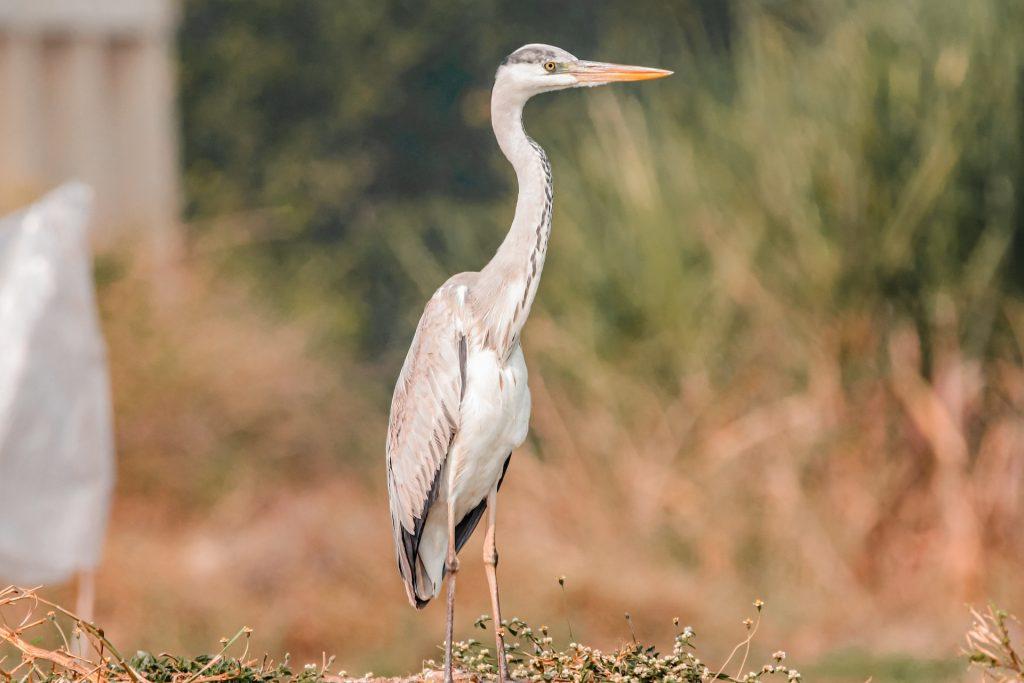
The Longrock Pool in Marazion Marsh is a particularly good spot where you may find the grey heron and the purple heron, a rare bird that migrates to the UK.
Gerrans Bay East and West and Fal Estuary are both territories that little egrets and grey herons frequent.
In the RSPB Hayle Estuary complex, you can come across grey herons and little egrets in the Copperhouse Creek and The Old Quay House.
During the summer, grey herons can also be spotted in the Crowdy Reservoir and around Penzance.
Grab Your Binos, Time for Watching Birds in Cornwall!
With so many great places for bird sightings in Cornwall, you’re almost guaranteed to catch a glimpse of these beautiful creatures.
Whether you’re spying on reclusive razorbills or praying to witness starling murmurations in Cornwall, birds will always be a wildlife highlight during your visit to the county.
Go grab your binoculars and head over to one of Cornwall’s top birdwatching spots!

Introducing Eliot, the Editor here and Cornwall local with a wanderlust spirit and an insatiable appetite for adventure. With a passion for the great outdoors, he can often be found catching waves on his surfboard, scaling peaks on a hiking trail, or discovering hidden gems in his exploration of Cornwall.
